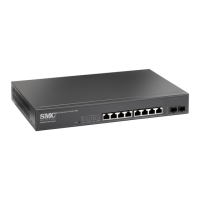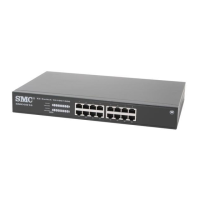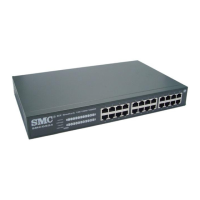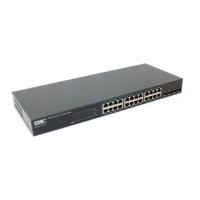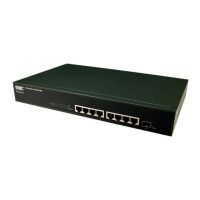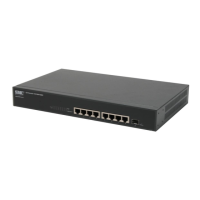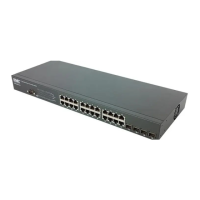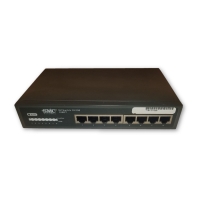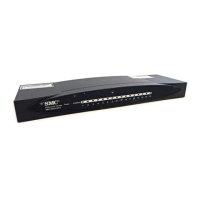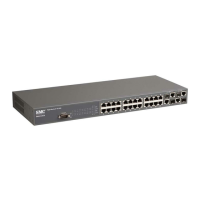Chapter 4: Configuring the Switch Page: 41 Setting an IP Address Details how to configure an IP interface for management access, supporting both IPv4 and IPv6.
Setting an IPv6 Address Details IPv6 configuration, including link-local and global unicast addresses, and auto-configuration.
Configuring NTP Service Describes how to configure Network Time Protocol (NTP) servers for accurate time synchronization on the switch.
Configuring Security Outlines security measures including management access, general security, and user account configuration.
Management Access Security Details controlling management access via local authentication, RADIUS, TACACS+, SSH, HTTPS, and static IP.
General Security Measures Outlines methods for traffic segregation, including Private VLANs, 802.1X, DHCP Snooping, and ARP Inspection.
Configuring SSH Details how to configure Secure Shell (SSH) access for secure remote management.
Configuring HTTPS Guides on enabling Secure Hypertext Transfer Protocol (HTTPS) for secure web interface access.
Configuring SNMPv3 Users Explains how to define unique names, engine IDs, security levels, and protocols for SNMPv3 users.
Configuring SNMPv3 Groups Guides on configuring SNMPv3 groups to define access policies for users and restrict access to MIB objects.
Using Port Security Illustrates how Port Security works with EAPOL and RADIUS for client authentication and access control.
ACE Configuration Details ingress port and frame type criteria for Access Control Entries (ACEs).
Configuring DHCP Snooping Explains filtering IP traffic on insecure ports by tracking hosts and preventing rogue DHCP servers.
Creating Trunk Groups Explains creating virtual aggregate links by grouping multiple physical links for increased bandwidth and fault tolerance.
Configuring Static Trunks Details configuring aggregation mode and members for static trunk groups, compatible with Cisco EtherChannel.
Configuring LACP Guides on enabling LACP on selected ports, configuring administrative key, and protocol initiation mode for dynamic trunks.
Configuring MIST Interfaces Explains configuring STA attributes for interfaces within a specific MSTI, covering path cost and port priority.
IGMP Snooping Introduces IGMP snooping for filtering multicast traffic by monitoring IGMP messages between hosts and routers.
Configuring IGMP Filtering Explains filtering specific multicast traffic on ports by denying access to specified multicast services.
MLD Snooping Introduces MLD snooping for limiting IPv6 multicast traffic forwarding to ports with users requesting it.
Configuring MLD Filtering Explains filtering specific multicast traffic on ports by denying access to specified multicast services.
Power Over Ethernet Details setting maximum PoE power, power budget, operating mode, priority, and allocation for ports.
Power Management Mode Details the two modes (Actual Consumption, Reserved Power) for configuring when ports shut down to manage power.
IEEE 802.1 Q VLANs Explains using VLANs to organize network nodes into separate broadcast domains for security and efficiency.
Using Port Isolation Explains preventing communications between customer ports within the same private VLAN.
Protocol VLANs Explains configuring VLANs based on protocol types to group devices participating in specific protocols.
Managing VoIP Traffic Recommends isolating VoIP traffic in a Voice VLAN for better quality, security, and QoS.
Quality of Service Explains how to prioritize data packets based on class information for better network performance during congestion.
Configuring QoS Control Lists Explains configuring QoS policies for handling ingress packets based on various criteria like Ethernet type, VLAN ID, and DSCP.
Configuring Storm Control Guides on setting limits for broadcast, multicast, and unknown unicast traffic to control traffic storms.
Configuring Port Mirroring Explains mirroring traffic from source ports to a target port for real-time analysis using logic analyzers or RMON probes.
Configuring UPnP Details configuring Universal Plug and Play (UPnP) for seamless device connectivity and simplified network deployment.
Chapter 5: Monitoring the Switch Page: 199 Displaying Log Messages Explains how to scroll through logged system and event messages using the System Log Information page.
Displaying QoS Statistics Details how to display the number of packets processed by each service queue using Queuing Counters.
Displaying QCL Status Guides on showing QoS Control List (QCE) entries and checking for conflicts using the QoS Control List Status page.
Displaying ACL Status Explains how to show ACL status, including ingress port, frame type, and forwarding action for each ACE.
Displaying MVR Statistics Guides on displaying statistics for IGMP protocol messages used by MVR, including VLAN ID and reports received.
Showing IPv4 SSM Information Explains displaying IGMP Source-Specific Information, including group, filtering mode, source address, and type.
Displaying LLDP Information Explains using monitor pages for LLDP to display advertised information from neighbors and control frame statistics.
Displaying PoE Status Explains displaying status for all PoE ports, including PD class, requested, allocated, used power, and priority.
VLAN Membership Guides on displaying current port members for all VLANs configured by a selected software module.
VLAN Port Status Explains displaying VLAN attributes of port members, including PVID, ingress filtering, and frame type.
